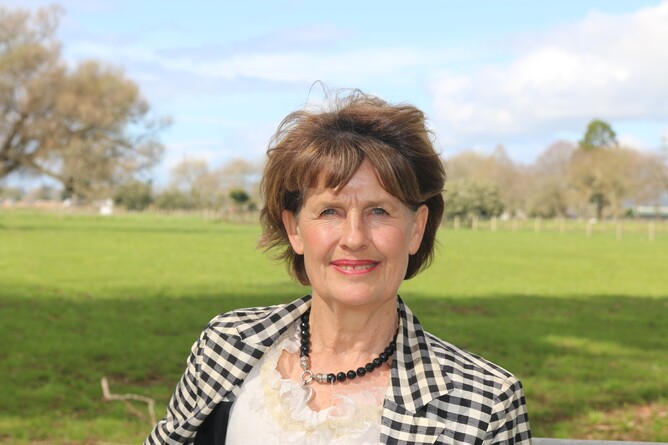An educator and businesswoman with a strong background in animal science has joined CRV Ambreed, taking on a newly created stakeholder engagement role to promote LowN Sires.
Lynda Clark taught animal science at Lincoln University for 16 years and was the founding general manager of Dairy Women’s Network. She also holds governance roles and works as a coach and facilitator.
“We are really pleased to have Lynda join our team at CRV Ambreed,” says CRV Ambreed’s Managing Director Angus Haslett. “She brings to the role not only an understanding of animal science and the power of genetics, she’s skilled at talking to people, bringing people together and will do a great job at telling the CRV Ambreed story of better cows, better life.”
The new engagement role has been created by CRV Ambreed to build awareness and continue conversations around its recent ground-breaking genetic discovery, LowN Sires, which has the potential to change dairy farming in New Zealand.
In March, CRV Ambreed announced the discovery, thought to be a world-first, which could reduce nitrogen leaching on New Zealand farms by 20% within 20 years.
CRV Ambreed identified and selected bulls genetically superior for a new trait related to the amount of urea nitrogen in milk. Farmers are now able to breed cows using straws of semen from CRV Ambreed’s LowN Sires, and those daughters will have reduced concentration of Milk Urea Nitrogen (MUN).
Cows bred for lower levels of MUN are expected to excrete less nitrogen in their urine which will, in turn, reduce the amount of nitrogen leached from grazed pasture. This could potentially save New Zealand 10 million kilograms in nitrogen leaching a year, based on the national herd number of 6.5 million dairy cattle.
CRV Ambreed has been researching the connection between MUN and nitrogen in urine for five years, and Clark says the genetic discovery is an important one for sustainability in New Zealand.
She says sustainable farm practices and improving the quality of waterways are “hot topics”. “Farmers are using many management practices to reduce nitrogen loss, and LowN Sires is another powerful tool. It’s “an easy, no additional cost and simple solution” to reducing nitrogen leaching on dairy farms, she says.
“I want to ensure we are engaging with stakeholders at all levels - key farmer networks and people making policy nationally and regionally. Also, it is really important that people are driving through the farm gate to talk with farmers now about this option,” says Clark. “That means talking to everyone from regional councils to large agricultural companies and organisations who work with farmers, to large farming entities and farming trusts.
“I think we need to be able to put our hands on our heart, and say we are doing all we can to make a difference,” says Clark. “There is increased pressure on councils to improve the quality of waterways, and to be accountable. So, part of my job is to raise awareness of LowN Sires and let them know more about this innovation, which has the potential to make a difference to farmers.”
Clark says many dairy farmers are already doing a good job at incorporating sustainability into their farm practices, including riparian planting, fencing and better on-farm management practices. She says LowN Sires is a piece of the puzzle. “It’s a powerful tool in a farmer’s toolbox, and it’s something that can have an impact at no extra cost – it’s as easy as choosing this straw (of semen) over that straw.”
She will travel the country to meet with large-scale stakeholders, including regional councils, large agricultural bodies and companies, and large farming trusts and corporations. “I’m looking forward to having conversations and understanding the challenges they are facing,” says Clark, who invites people to contact her at Lynda.clark@crv4all.co.nz
Clark has a long association with CRV Ambreed and the genetics research it undertakes – she’s the partner of CRV Ambreed R&D Scientist Phil Beatson.
In July CRV Ambreed also announced it had identified that when cows are bred for low milk urea concentration, a proportion of the nitrogen diverted away from the cow’s urea, goes into milk protein.
This finding gives CRV Ambreed further confidence that breeding cows for low milk urea concentration will not only reduce the amount of nitrogen excreted in their urine, but will also increase the efficiency with which dietary nitrogen is used for milk protein production.
How low MUN and LowN Sires works
The primary cause of nitrogen leached into the ground and waterways comes from the cow’s urine having very high concentration of nitrogen and being deposited in small patches. Some of the nitrogen excreted is converted to gas, some is taken up by plants, and a substantial amount is leached, with soil-type affecting the proportion that is leached.
CRV Ambreed, with the input of other researchers, has spent five years investigating the genetics of Milk Urea Nitrogen (MUN). The rationale has been that if it’s possible to reduce MUN through traditional genetic selection means, and providing the relationship between MUN and amount of nitrogen excreted in urine holds, then the genetically improved animals for MUN will excrete less urinary nitrogen and hence leaching per animal and per hectare can be reduced.
“Cows bred for lower levels of MUN are expected to excrete less nitrogen in their urine which will, in turn, reduce the amount of nitrogen leached when cows are grazed on pasture,” CRV Ambreed R&D Scientist Phil Beatson says.
“Farmers who include low-MUN in their breeding programme now add another tool to their farming systems to manage nitrate leaching and are looking at potential nitrogen leaching reductions of 10-12% by 2025.” That’s significant, Beatson says, and it comes with minimal or no disruption to normal farm management practices.
Genetic studies have found that MUN is a heritable trait and that it is possible to reduce MUN through genetic selection. But that avenue has not been pursued overseas where alternative farming systems mean cows are not on pasture as much as they are in New Zealand and nitrogen leaching from urine patches is possibly not as important an issue as it is here.
Beatson’s research was designed to identify superior bulls for MUN with the specific aim being to provide low-MUN bulls to breed cows that excrete less nitrogen in their urine: in line with overseas studies he has identified some bulls that will breed daughters that have desired low levels of MUN, while at the other end of the scale some bulls will breed daughters with high levels of MUN.
CRV Ambreed is the first organisation in New Zealand, and possibly the world, to market bulls with low-MUN genetics with the aim being to provide a long-term genetic solution to nitrogen leaching.
Since 2012, CRV Ambreed has measured MUN concentration in 650,000 milk samples and analysed them to understand how strongly the trait is inherited, and to create a MUN breeding value for all cows measured as well as sires of the cows. MUN cow breeding values (BVs) can be made available to farmers who herd test and herd record with CRV Ambreed meaning they can effectively manage their breeding programmes around low-MUN.

